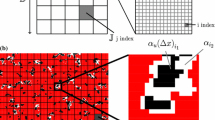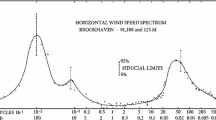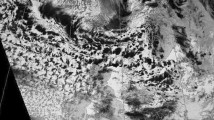Abstract
Buoyancy fluxes in the marine atmospheric boundary layer (MABL) for the cloud street regime, observed during the Genesis of Atlantic Lows Experiment (GALE), have been analyzed using the technique of joint frequency distribution. For the lower half of the MABL, the results suggest that the buoyancy flux is mainly generated by the rising thermals and the sinking compensating ambient air, and is mainly consumed by the entrainment and detrainment of thermals, penetrative convection, and the entrainment from the MABL top.
The results are compared to those from previous studies of mesoscale cellular convection (Air-Mass Transformation Experiment, AMTEX), the dry convective boundary layer, and the trade-wind MABL. For the lower MABL, the quadrant buoyancy fluxes, fractional coverages, and flux intensities are in good agreement with those of mesoscale cellular convection (AMTEX) and the dry convective boundary layer. The results suggest that, if the buoyancy flux is primarily driven by the temperature flux, the physical processes for generating buoyancy flux mentioned above are about the same for the lower boundary layers over land and ocean, even with different convective regimes. For the trade-wind MABL, the buoyancy flux is mainly driven by the moisture flux; the quadrant flux intensities are stronger than those of the other three studies except for the buoyant updrafts (thermals). These results suggest that the entrainment and detrainment of thermals are more effective in the trade-wind MABL than in the boundary layers driven by the temperature flux.
Scale analysis of the buoyancy flux is in good agreement with that of AMTEX. For the lower half of the MABL, the buoyancy flux is mainly generated by the intermediate scale (200 m to 2 km), which includes the dominant convective thermals in the surface layer and the mixed layer. The scale smaller than 200 m is important only in the surface layer. The scale larger than 2 km, which includes the roll vortices, increases its significance upward. While most of the positive and negative fluxes are associated with the updrafts for the intermediate scale, the downdrafts are as important as updrafts for the larger scale.
Similar content being viewed by others
References
Agee, E. M. and Howley, R. P.: 1977, ‘Latent and Sensible Heat Flux Calculations at the Air-Sea Interface During AMTEX 74’, J. Appl. Meteorol. 16, 443–447.
Betts, A. K.: 1982, ‘Saturation Point Analysis of Moist Convective Overturning’, J. Atmos. Sci. 39, 1484–1505.
Brown, R. A.: 1980, ‘Longitudinal Instabilities and Secondary Flows in the Planetary Boundary Layer: A Review’, Rev. Geophys. Space Phys. 18, 683–697.
Bunker, A. and Worthington, L. V.: 1976, ‘Energy Exchange Charts of the North Atlantic Ocean’, Bull. Amer. Meteorol. Soc. 57, 450–467.
Caughey, S. J. and Wyngaard, J. C.: 1979, ‘The Turbulence Kinetic Energy Budget in Convective Conditions’, Quart. J. Roy. Meteorol. Soc. 105, 231–239.
Chou, S.-H. and Yeh, E.-N.: 1987, ‘Airborne Measurements of Surface Layer Turbulence Over the Ocean During Cold Air Outbreaks’, J. Atmos. Sci. 44, 3721–3733.
Chou, S.-H., Atlas, D., and Yeh, E.-N.: 1986, ‘Turbulence in a Convective Marine Atmospheric Boundary Layer’, J. Atmos. Sci. 43, 547–564.
Dirks, R. A., Kuettner, J. P., and Moore, J. A.: 1988, ‘Genesis of Atlantic Lows Experiment (GALE): An Overview’, Bull. Amer. Meteorol. Soc. 69, 148–160.
Friehe, C. A., Grossman, R. L., and Pann, Y.: 1986, ‘Calibration of an Airborne Lyman-Alpha Hygrometer and Measurement of Water Vapor Flux Using a Thermoelectric Hygrometer’, J. Atmos. and Ocean. Tech. 3, 299–304.
Frisch, A. S. and Businger, J. A.: 1973, ‘A Study of Convective Elements in the Atmospheric Surface Layer’, Boundary-Layer Meteorol. 3, 301–328.
Graham, R. J.: 1963, ‘Determination and Analysis of Numerical Smoothing Weights’, NASA Tech. Rep. TR-179 [NTIS N65-13828].
Grossman, R. L.: 1982, ‘An Analysis of Vertical Velocity Spectra Obtained in the BOMEX Fair-Weather, Trade-Wind Boundary Layer’, Boundary-Layer Meteorol. 23, 323–357.
Grossman, R. L.: 1984, ‘Bivariate Conditional Sampling of Moisture Flux over a Tropical Ocean’, J. Atmos. Sci. 41, 3238–3253.
Holland, J. Z.: 1968, ‘An Application of Some Statistical Techniques to the Study of Eddy Structure’, Atomic Energy Comm. Tech. Rep., 378 pp. [TID-24585].
Holland, J. Z.: 1973, ‘A Statistical Method for Analyzing Wave Shapes and Phase Relationships of Fluctuating Geophysical Variables’, J. Phys. Oceanogr. 3, 139–155.
Kaimal, J. C., Wyngaard, J. C., Haugen, D. A., Coté, O. R., Izumi, Y., Caughey, S. J., and Readings, C. J.: 1976, ‘Turbulence Structure in the Convective Boundary Layer’, J. Atmos. Sci. 33, 2152–2169.
Khalsa, S. J. S. and Greenhut, G. K.: 1985, ‘Conditional Sampling of Updrafts and Downdrafts in the Marine Atmospheric Boundary Layer’, J. Atmos. Sci. 42, 2550–2562.
Kuettner, J. P.: 1971, ‘Cloud Bands in the Earth's Atmosphere: Observations and Theory’, Tellus 23, 404–426.
Lanczos, C.: 1956, Applied Analysis. Prentice Hall, Englewood Cliffs, NJ, 539 pp.
LeMone, M. A.: 1973, ‘The Structure and Dynamics of Horizontal Roll Vortices in the Planetary Boundary Layer’, J. Atmos. Sci. 30, 1077–1091.
LeMone, M. A.: 1976, ‘Modulation of Turbulence Energy by Longitudinal Rolls in an Unstable Boundary Layer’, J. Atmos. Sci. 33, 1308–1320.
LeMone, M. A. and Pennell, W. T.: 1980, ‘A Comparison of Turbulence Measurements from Aircraft’, J. Appl. Meteorol. 19, 1420–1437.
Lenschow, D. H. and Stephens, P. L.: 1980, ‘The Role of Thermals in the Convective Boundary Layer’, Boundary-Layer Meteorol. 19, 509–522.
Lenschow, D. H., Wyngaard, J. C., and Pennell, W. T.: 1980, ‘Mean-Field and Second-Moment Budgets in a Baroclinic, Convective Boundary Layer’, J. Atmos. Sci. 37, 1313–1326.
Mahrt, L.: 1976, ‘Mixed Layer Moisture Structure’, Mon. Wea. Rev. 104, 1403–1407.
Mahrt, L. and Paumier, J.: 1984, ‘Heat Transport in the Atmospheric Boundary Layer’, J. Atmos. Sci. 41, 3061–3075.
Moeng, C. H. and Wyngaard, J. C.: 1984, ‘Statistics of Conservative Scalars in the Convective Boundary Layer’, J. Atmos. Sci. 21, 3161–3169.
Nicholls, S. and Readings, C. J.: 1979, ‘Aircraft Observations of the Structure of the Lower Boundary Layer Over the Sea’, Quart. J. Roy. Meteorol. Soc. 105, 785–802.
Pennell, W. T. and LeMone, M. A.: 1974, ‘An Experimental Study of Turbulence Structure in the Fair-Weather Trade Wind Boundary Layer’, J. Atmos. Sci. 31, 1308–1323.
Stull, R. B.: 1976, ‘The Energetics of Entrainment across a Density Interface’, J. Atmos. Sci. 33, 1260–1267.
Wilczak, J. M. and Businger, J. A.: 1983, ‘Thermally Indirect Motions in the Convective Atmospheric Boundary Layer’, J. Atmos. Sci. 40, 343–358.
Wyngaard, J. C., Coté, O. R., and Izumi, Y.: 1971, ‘Local Free Convection, Similarity, and the Budgets of Shear Stress and Heat Flux’, J. Atmos. Sci. 28, 1171–1182.
Wyngaard, J. C., Pennell, W. T., Lenschow, D. H., and LeMone, M. A.: 1978, ‘The Temperature-Humidity Covariance Budget in the Convective Boundary Layer’, J. Atmos. Sci. 35, 47–58.
Author information
Authors and Affiliations
Additional information
ST Systems Corporation, Lanham, MD, 20706, U.S.A.
Rights and permissions
About this article
Cite this article
Chou, SH., Zimmerman, J. Bivariate conditional sampling of buoyancy flux during an intense cold-air outbreak. Boundary-Layer Meteorol 46, 93–112 (1989). https://doi.org/10.1007/BF00118448
Accepted:
Issue Date:
DOI: https://doi.org/10.1007/BF00118448




